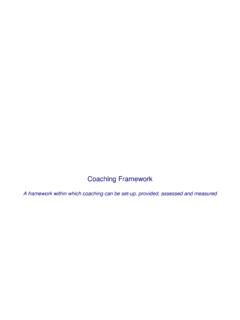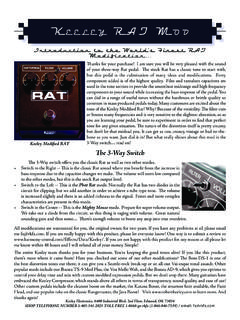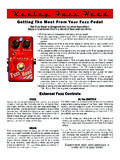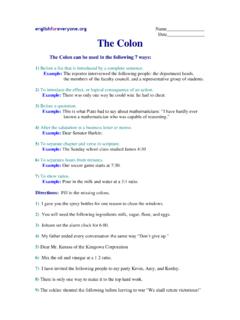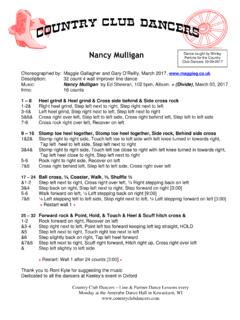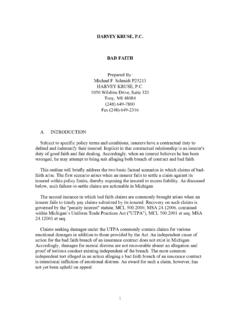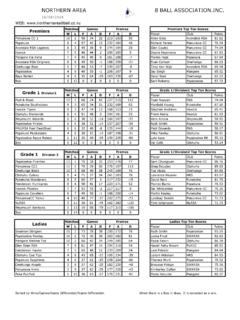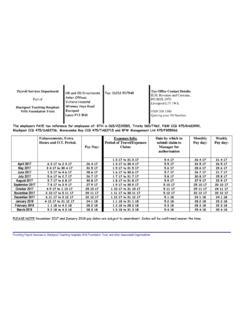Transcription of Moving Towards Safe Uncertainty
1 Moving Towards safe Uncertainty : The Development of Resilience and Excitement in the Future. On the shoulders of giants: I see this paper as a living, breathing journey rather than a final outcome. This version is one I am sharing now and I hope to develop and extend it as I continue my exploration and learning in this topic. I hope it is useful. None of the material in here is mine although I might have brought a particular way of thinking to it. Feel free to use it as you like, without reference to me, although I. would appreciate it if you gave due respect to my sources. I was first introduced to the concept of safe Uncertainty in 1998/9 by Dr Linda Hoyle, then of the Tavistock Consulting Service, when she and I co-created their Managing Continuous Change developmental workshop. Linda has a number of very useful and interesting concepts related to our often unconscious responses to change some of which are covered in her contribution to the book Working Below The Surface (1).
2 Since then I have developed a real interest in the whole topic of resilience and self-sufficiency. Khurshed Dehnugara and Claire Breeze of Relume introduced me to the work of Viktor Frankl (2) in the context of getting under the skin of our habitual limiting thinking and it has really helped me developing my own thinking about Uncertainty and how we deal with it. Darren Rudkin introduced me to the similar concept of Trigger, Filter, State and the idea that life is our greatest teacher. Dr Brian Marien has helped me considerably in understanding the impact of my cognition on my emotions and introduced me to the seminal work of Joseph LeDoux (9). Annika Ratcliffe of Human Insight has, for years, helped me grow my understanding of business ecology and emergent change, particularly with the work of Dr Peter Robertson (3) around S curves and attachment.
3 Clare Southall, also of Relume, encouraged me to dust off the books I had by Meg Wheatley (4) around emergent change and how we as humans try to control change inappropriately rather than harnessing the natural order of things. Dr Josie Gregory, senior lecturer in Management at Surrey University and co-founder of the Foundation for Workplace Spirituality reinforced for me the power of Byron Katie's work (5) and more recently Cathy Reilly introduced me to the work of Barry Mason (6) and the concept of authoritative doubt which I have found very useful. I am grateful for the catalyst that Alexandra Smith of SWAN consulting has provided in encouraging me to bring together all of this thinking for some work she and I have been doing together using Alexandra's very powerful COMPASS developmental process. Introduction: For many years the study of change management and leadership revolved around the provision of control and certainty to those who were impacted by the changes so as to alleviate a very natural cause of resistance to change that being lack of control, Uncertainty of the future and fear that we will be unable to cope.
4 Good practice change leadership therefore often includes the active involvement of impacted people and the co-creation of ideal outcomes so as to harness their resources and give them some sense of control over the future. Jeremy keeley March 2009 1. The only certainty is that life is uncertain Susan Jeffers (7). Whilst not denying the powerful impact of this involvement in reducing and harnessing resistance as well as in enhancing the quality of the change outcome, this approach is also limited (and sometimes disingenuous) in that control is not available to be provided and not within the remit of those leading the change or doing the involvement and empowering. Recent headlines have included lines such as the only certainty is Uncertainty and indicate the realistic nature of life all of life shows up as impermanent and the only certainty is that one day we will die.
5 Doubt, it seems to me, is the central condition of a human being in the 20th Century. One of the things that have happened to us in the 20th Century as a human race is to learn how certainty crumbles in your hand. We cannot any longer have a fixed view of anything the table we're sitting next to, the ground beneath our feet, the laws of science, are full of doubt now. Salmon Rushdie (6). Latest thinking in change leadership has therefore evolved whereby a powerful element of a change leader's work is in building the resilience of their people and enabling them to live more comfortably with impermanence, Uncertainty , ambiguity and lack of control. Underpinning work in this area is the hypothesis that, as humans, when we are asleep to our reactions, we confuse safety with certainty. We assume they are the same thing and we therefore unconsciously (and sometimes consciously) move Towards safe certainty.
6 Because this is an unrealistic space, we therefore find ourselves blocking, defending, denying and controlling. As we become awake to our unconscious intention, we might allow ourselves to distinguish more clearly between that which keeps us safe (physically, emotionally, psychologically and spiritually) and our unconscious drive for certainty allowing ourselves to work Towards safe Uncertainty a space which by its nature is open to exploration, possibility, learning and energy . a much more realistic space, in which of course, we might also experience the very natural exploratory discomfort. Jeremy keeley March 2009 2. safe Unrealistic Edgy Blocked Energetic Denying Learning Controlling Empowering Certain Uncertain Dangerous Vulnerable Damaging Rudderless Unsafe The key essence of the work of Moving Towards safe Uncertainty is enabling individuals to: Find their own purpose in the world, a true north which guides them - regardless of circumstance, regardless of what life throws at them together with real clarity on their values, positive human qualities and core strengths which will support them in their endeavours.
7 See life not as a source of problems but as a key source of learning;. Understand and distinguish between their real and genuine need for safety and their apparent and false need for certainty, enabling them to really focus on safety whilst thriving in Uncertainty and allowing the possibilities to emerge. Key principles: When the forms of an old culture are dying, the new culture is created by a few people who are not afraid to be insecure. (Rudolf Bahro as quoted by Meg Wheatley (4)). The key principles underpinning the idea of Moving Towards safe Uncertainty are: Uncertainty could be seen as a path to creativity through possibility or as a path to paralysis our own mindset determines which path we take;. When our concept of being safe is wedded to being certain, we almost certainly make ourselves unsafe because we are constantly trying to control things that eventually will not be controlled, and we are usually disappointed because life will show up differently from the expectations we have become attached to.
8 Jeremy keeley March 2009 3. There is a release and relief in opening up to what life offers that then allows a real presence, an appreciation of life and the opportunity to really learn about ourselves and others. Possibility and creativity Paralysis The prime cause of our suffering is our wanting things to be different than they are! Susan Jeffers (7). Key components of safe Uncertainty : The position of Moving Towards safe Uncertainty , according to Barry Mason (6), is characterised by the following elements: We hold our beliefs and knowledge with authoritative doubt a balance of our expertise and our Uncertainty ;. We see nothing as fixed we see everything as always in a state of flow ( this too will );. The narrative of our life is respectful, collaborative and evolving we are in a constant state of impermanence (no joke intended).
9 We allow a context to emerge whereby new explanations can be placed alongside (rather than instead of) existing explanations and viewed curiously;. When unexpected things happen we are more likely to move Towards enquiry than Towards definition;. In our enquiry and exploration of life, we are more likely to explore meaning than we are to argue about facts;. In our lives we accept the reality that we will continuously be faced with dilemmas (having to choose between good and good, or bad and bad). We see solutions as dilemmas that are simply less of a dilemma than the dilemma we had before the solution a problem often does not have one simple resolution and solutions do not have to solve everything. Moving Towards safe Uncertainty is an ongoing journey a path rather than a destination (hence the way I precursor safe Uncertainty with Moving Towards in Jeremy keeley March 2009 4.)
10 This paper). There is a rich vein of work to be done here and this paper is only scratching at the surface of it. However, as a start point, key ways (inextricably linked with each other) in which we can consider Moving Towards safe Uncertainty include: Being curiously awake to ourselves noticing without judgement what we are thinking and feeling and how we are behaving and, crucially, what we are attached to Connecting with where and how we are genuinely safe and consciously creating the circumstances in which we can build that safety;. Embracing Uncertainty actively, deliberately, curiously and joyfully;. Letting life be life, living life in the present and dealing with life's occurrences as gifts with deep gratitude and an openness to what we can learn about both ourselves, others and the world;. Operating with a wider purpose and a longer term view.
